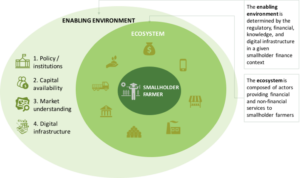For smallholder financial solutions to succeed, providers require support from an enabling environment. Previous ISF and Lab research identified components of this environment, from Inflection Point which demonstrated the relationship between financial service providers (FSPs) and capital providers, to ISF’s research on the role of government policy and smallholder finance and the market for technical assistance providers in developing countries.
The relationship between the enabling environment and smallholder finance is complex, and to date, there is limited research on the link between the success of specific smallholder products and services and factors in the enabling environment. However, the Mastercard Foundation’s rural and agricultural finance portfolio – ten programs spanning 26 countries in sub-Saharan Africa – should provide an opportunity to understand more about this relationship. Part 6 of the Pulse series highlights some early learnings from this portfolio and makes recommendations for future research to close the knowledge gap.
Defining the smallholder finance enabling environment and ecosystem
The smallholder finance environment is determined by at least four key elements, including the regulatory, financial, knowledge, and digital infrastructure of a given country or context.



